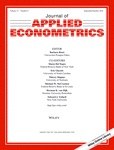
Basturk, N., Cakmakli, \.(., Ceyhan, P. and \van Dijk\, H. (2014). Posterior-predictive evidence on US inflation using extended New Keynesian Phillips Curve models with non-filtered data Journal of Applied Econometrics, 29(7):1164--1182.
-
Affiliated authorsPinar Ceyhan, Herman van Dijk
-
Publication year2014
-
JournalJournal of Applied Econometrics
Changing time series properties of US inflation and economic activity, measured as marginal costs, are modeled within a set of extended New Keynesian Phillips curve (NKPC) models. It is shown that mechanical removal or modeling of simple low-frequency movements in the data may yield poor predictive results which depend on the model specification used. Basic NKPC models are extended to include structural time series models that describe typical time-varying patterns in levels and volatilities. Forward- and backward-looking expectation components for inflation are incorporated and their relative importance is evaluated. Survey data on expected inflation are introduced to strengthen the information in the likelihood. Use is made of simulation-based Bayesian techniques for the empirical analysis. No credible evidence is found on endogeneity and long-run stability between inflation and marginal costs. Backward-looking inflation appears stronger than forward-looking inflation. Levels and volatilities of inflation are estimated more precisely using rich NKPC models. The extended NKPC structures compare favorably with existing basic Bayesian vector autoregressive and stochastic volatility models in terms of fit and prediction. Tails of the complete predictive distributions indicate an increase in the probability of deflation in recent years.